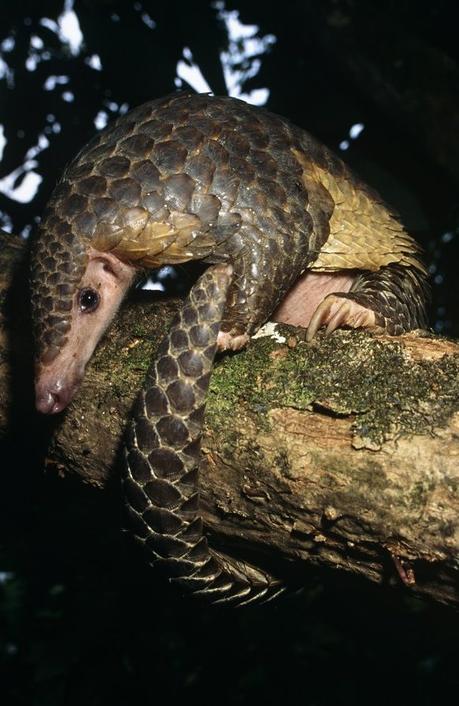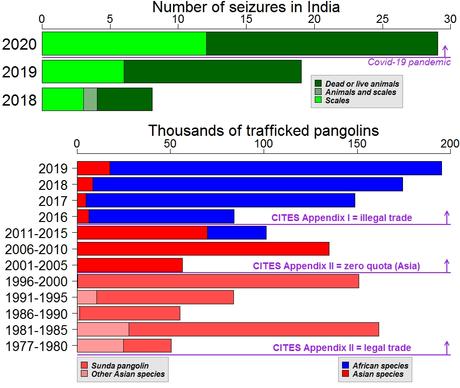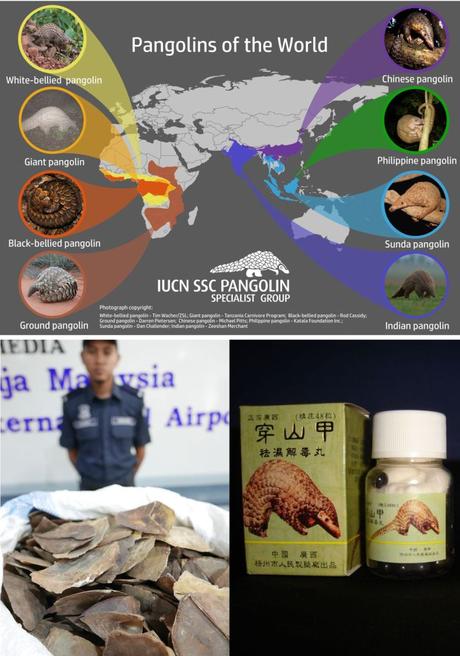The logic of money contradicts the logic of species conservation and human health. As illegal trade has driven pangolins to near extinction, their hunting and market value has kept increasing ― even when we have known that they act as coronavirus reservoirs in the middle of the Covid-19 pandemic.
 Sunda pangolin (Manis javanica) in a monsoon forest (Sumba Island, Indonesia). With adult weights up to 10 kg and body lengths around half a metre, these animals are mostly solitary and nocturnal, feed on ants and termites, and love tree climbing using bark hollows to shelter and give birth to singletons. The species occurs across mainland and islands of South East Asia, and became ‘Endangered’ in 2008 and ‘Critically Endangered’ in 2014, following a 80% decline in the last 20 years due to hunting and poaching. It has been the most heavily trafficked Asian species, and the IUCN’s assessment states: “… the incentives for harvesting and illegally trading in the species are universally high based on the high financial value of pangolin parts and derivatives”. Captive breeding is unlikely to deter wild collection because (among other reasons) farming costs are high (more so on a large scale) and, even if the species could be traded legally, wild versus farmed pangolin products and individuals are difficult to distinguish (23). Photo courtesy of Michael Pitts
Sunda pangolin (Manis javanica) in a monsoon forest (Sumba Island, Indonesia). With adult weights up to 10 kg and body lengths around half a metre, these animals are mostly solitary and nocturnal, feed on ants and termites, and love tree climbing using bark hollows to shelter and give birth to singletons. The species occurs across mainland and islands of South East Asia, and became ‘Endangered’ in 2008 and ‘Critically Endangered’ in 2014, following a 80% decline in the last 20 years due to hunting and poaching. It has been the most heavily trafficked Asian species, and the IUCN’s assessment states: “… the incentives for harvesting and illegally trading in the species are universally high based on the high financial value of pangolin parts and derivatives”. Captive breeding is unlikely to deter wild collection because (among other reasons) farming costs are high (more so on a large scale) and, even if the species could be traded legally, wild versus farmed pangolin products and individuals are difficult to distinguish (23). Photo courtesy of Michael PittsUrbanites are attracted to exotic species, materials, and places. Our purchasing power seems to give us the right to buy any ‘object’ that we can pay for, no matter how exotic the object might be. In such a capitalist rationale, it is no surprise that > 150 thousand illegal cargos with wild animals and plants have been confiscated in 149 countries over the last two decades, moving some 6000 species from one place of the planet to another (1).
Social networks show people interacting with all kinds of fauna, creating the illusion that any animal can become a pet (2). And there’s a multi-$billion market of wildlife for a diverse array of uses including collecting, food, ornamentation, leisure, clothing and medicine (3-5). The paradox is that the rarer a species is, the higher its market value runs and the more lucrative selling it turns out to be, leading to more exploitation and rocketing extinction risk (6).
The Covid-19 pandemic adds one layer of complexity to this problem. One could expect that the possibility a species might transmit a given disease to humans would surely reduce the demand for its trafficking, by the premise that transporting potentially infected animals to populated cities could multiply the chances of microbes jumping to humans, what is known as a ‘zoonosis‘ (7). But … market laws, and those who make a living from the wildlife trade, hardly care.
More covid, more trade
Pangolins illustrate the problem all too well. These insect-eating mammals are remarkable for their bodies fully covered by scales made of keratin (8), the same protein that hardens human finger nails. Both bats and pangolins are natural reservoirs of coronaviruses (9), and the human SARS-CoV-2 resembles an evolved form of coronavirus strains present in those mammals (10). Although we still debate the animal species from which we caught our coronavirus (11-13), a hypothetical pangolin host has been trumpeted in the media and on social networks.
Knowing the pangolin-coronavirus connection, Vikram Aditya and collaborators browsed the internet for cases of illegal pangolin trade in India from 2018 to 2020 (14). They found a total of 111 seizures, of which 65% were dead or living animals and the remainder consisted of scales. Due to the Covid-19 pandemic, the Indian population was locked down between March and May 2020, and followed gradual relaxation of social distancing over the rest of the year. However, from March to August annually, there were 10 to 20 more pangolin seizures in 2020 than in 2018 or 2019. So, illegal trade of pangolins increased the year of the SARS-CoV-2 irruption according to internet data.

The hypothetical sequence of events might have been as follows. Unemployment and closure of services in Indian cities due to the pandemic caused an exodus of people to the countryside (15). More people in rural areas meant more use of natural resources under weak to null control, because governments were allocating resources to manage the pandemic at the expense of other social needs (16). And the national and international networks of pangolin trade (17, 18) took advantage of the situation as a money-making opportunity (14).
When regulation leads to non-regulation
The Convention on International Trade in Endangered Species (CITES) can be held (unwillingly) responsible for the decline of the wild populations of the 8 extant species of pangolins. Every change in trade regulation by CITES has modified trade patterns.
These animals were initially legally traded under CITES Appendix II since 1977. In response to unsustainable hunting and trading piling up, CITES imposed a zero quota on all Asian species in 2000, which cascaded into two market shifts:
(i) the predominant product of trade changed from skins to scales and individuals, and
(ii) trafficking of African species (with final destinations in Asia) rocketed.
In 2016 (see IUCN news and CITES report), CITES reacted by placing all eight species in its Appendix I that bans all types of trade. However, the new status seems to have stimulated illegal trade further (17). In 2019 alone, the volume of seizures amounted to ~ 200,000 pangolins (20 tonnes in weight). Since CITES started regulating the pangolin market, the volume of illegal trade (which is always difficult to quantify) has vastly exceeded the volume of legal trade (17).

China and Vietnam are the main consumers of pangolin products, which are deeply rooted in cultural beliefs and traditions (listen here* and read and watch here). Managing illegal trade by Western countries, with the sole goal of saving species and protecting nature, is often interpreted as a green form of neocolonialism (19) and fails to modify consumer habits (20). The challenge to solve is that control measures will remain useless by themselves if neglecting the motivations and cultural context of the demand.
A Spanish version of this blog has been published by the journal Quercus in December 2021.
*NOTE: Sustainable Asia has produced a four-chapter series on pangolins including:
- Why are pangolins so prized in China (listen)
- Pangolins, poverty and porous borders (listen)
- Demand for pangolins in Southeast Asia (listen)
- Will coronavirus change the pangolins’ fate? (listen)
References
- United Nations Office on Drugs and Crime (2020) World Wildlife Crime Report. Traficking in protected species
- McMillan SE et al. (2021). Exotic animal cafes are increasingly home to threatened biodiversity. Conserv Lett 14:e12760
- Rizzolo JB (2021). Effects of legalization and wildlife farming on conservation. Global Ecol Conserv 25:e01390
- Baker SE et al. (2013). Rough trade: animal welfare in the global wildlife trade. BioScience 63:928-938
- Rosen GE & Smith KF (2010). Summarizing the evidence on the international trade in illegal wildlife. EcoHealth 7:24-32
- Courchamp F et al. (2006). Rarity value and species extinction: the anthropogenic Allee effect. PLoS Biol 4:e415
- Swift L et al. (2007). Wildlife trade and the emergence of infectious diseases. EcoHealth 4:25-30
- Gaubert P et al. (2018). The complete phylogeny of pangolins: scaling up resources for the molecular tracing of the most trafficked mammals on Earth. J Hered 109:347-359
- Zhang T, Wu Q & Zhang Z (2020). Probable pangolin origin of SARS-CoV-2 associated with the COVID-19 outbreak. Curr Biol 30:1346-1351
- Touati R et al. (2020). Comparative genomic signature representations of the emerging COVID-19 coronavirus and other coronaviruses: high identity and possible recombination between bat and pangolin coronaviruses. Genomics 112:4189-4202
- Frutos R et al. (2020). COVID-19: time to exonerate the pangolin from the transmission of SARS-CoV-2 to humans. Infect Gen Evol 84:104493
- Andersen KG et al. (2020). The proximal origin of SARS-CoV-2. Nat Med 26:450-452
- Lam TT-Y et al. (2020). Identifying SARS-CoV-2-related coronaviruses in Malayan pangolins. Nature 583:282-285
- Aditya V et al. (2021). Scale of the issue: mapping the impact of the COVID-19 lockdown on pangolin trade across India. Biol Conserv 257:109136
- Mukhra R, Krishan K & Kanchan T (2020). COVID-19 sets off mass migration in India. Arch Med Res 51:736-738
- Evans KL et al. (2020). Conservation in the maelstrom of Covid-19 – a call to action to solve the challenges, exploit opportunities and prepare for the next pandemic. Anim Conserv 23:235-238
- Challender DWS et al. (2019). International trade and trafficking in pangolins, 1900-2019. Pangolins: Science, Society and Conservation:259-276
- Heinrich S et al. (2016). Where did all the pangolins go? International CITES trade in pangolin species. Global Ecol Conserv 8:241-253
- Burgess G et al., in Pangolins: Science, Society and Conservation, DWS Challender, HC Nash & C Waterman, Eds. (Academic Press, 2020), pp. 349-366
- Veríssimo D & Wan AKY (2019). Characterizing efforts to reduce consumer demand for wildlife products. Conserv Biol 33:623-633
- Sexton R, Nguyen T & Roberts DL (2021). The use and prescription of pangolin in traditional Vietnamese medicine. Trop Conserv Sci 14:1940082920985755
- Wang Y, Turvey ST & Leader-Williams N (2020). Knowledge and attitudes about the use of pangolin scale products in Traditional Chinese Medicine (TCM) within China. People Nat 2:903-912
- Challender DWS et al. (2019). Evaluating the feasibility of pangolin farming and its potential conservation impact. Global Ecol Conserv 20:e00714

